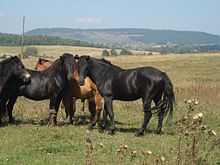Bosnian Mountain Horse
 | |
| Other names | |
|---|---|
| Country of origin | Bosnia and Herzegovina |
| Traits | |
| Weight |
|
| Height |
|
The Bosnian Mountain Horse (Bosnian: Bosanski brdski konj / Босански брдски коњ)[1] is the only indigenous breed of domestic horse in Bosnia and Herzegovina, where it constitutes about 70% of the horse population. It is a small horse and is used both as a pack animal and for riding. Breed numbers were severely reduced during the Bosnian War of 1992–1995, and, unlike populations of other farm animals, continued to fall after the end of the war.[5]
History[]

Selective breeding of the Bosnian Mountain Horse began at the stud of Goražde in 1908. The principal centres for the selection of the breed were the stud farms of Borike, in the municipality of Rogatica, and Han Pijesak. Three stallion lines – Agan, Barut and Miško – and nine mare lines were established; the Agan line is lost, and the Barut and Miško lines heavily mixed. Arab stallions at the Borike stud were used to improve the Bosnian Mountain Horse.[5] The Glasinacki type has substantial Arab influence; it is named after the village of Glasinac on the Romanija mountain, in the eastern part of the Republika Srpska.[2][6]: 35 A smaller type, the Podveleški, is found in Herzegovina.[3]
During the Bosnian War of 1992–1995 horse populations, like those of other farm animals, suffered heavily. In the Federation of Bosnia and Herzegovina, the total number of horses fell from 46,628 in 1990 to 16,080 in 1995, and by 2002 had fallen further to 7,014, or about 15% of the pre-war number; in the Republika Srpska numbers also fell, though not so steeply. Overall, horse numbers in Bosnia and Herzegovina fell by 68% between 1990 and 2002.[5]
The breed has not been substantially affected by importations of foreign horses. It is in some areas the principal, or even the only, means of transportation.[5]
References[]
- ^ a b c Breed data sheet: Bosnian Mountain/Bosnia and Herzegovina. Domestic Animal Diversity Information System of the Food and Agriculture Organization of the United Nations. Accessed October 2014.
- ^ a b Breed data sheet: Glasinacki/Bosnia and Herzegovina. Domestic Animal Diversity Information System of the Food and Agriculture Organization of the United Nations. Accessed October 2014.
- ^ a b Breed data sheet: Podveleski/Bosnia and Herzegovina. Domestic Animal Diversity Information System of the Food and Agriculture Organization of the United Nations. Accessed October 2014.
- ^ Maurizio Bongianni (1988). Simon & Schuster's Guide to Horses and Ponies. Simon & Schuster, Inc., p. 159. ISBN 067166068-3
- ^ a b c d [State Veterinary Administration of Bosnia and Herzegovina] (s.d.). Animal genetic resources in Bosnia and Herzegovina, annex to: Barbara Rischkowsky, D. Pilling (eds.) (2007). The State of the World's Animal Genetic Resources for Food and Agriculture. Rome: Food and Agriculture Organization of the United Nations. ISBN 9789251057629. Accessed October 2014.
- ^ Waltraud Kugler, Hans-Peter Grunenfelder, Elli Broxham (2008). Donkey Breeds in Europe: Inventory, Description, Need for Action, Conservation; Report 2007/2008. St. Gallen, Switzerland: Monitoring Institute for Rare Breeds and Seeds in Europe. Archived 2 September 2009.
Further reading[]
- Enver Žiga, Refik Telalbašič (2008). Bosanski brdski konj: monografija = The Bosnian Mountain Horse - monograph. Sarajevo: TKD Šahinpašic.
- Gertrud Grilz-Seger, Thomas Druml (2015). Das Bosnische Gebirgspferd. Graz: Vehling Verlag GmbH. ISBN 9783853332634.
- Refik Telalbašić, Enver Žiga, Alma Rahmanović (2011). Matična knjiga Bosanskog brdskog konja. Sarajevo: TKD Šahinpašić. ISBN 9789958414473.
| Wikimedia Commons has media related to Bosnian Pony. |
- Horse breeds
- Horse breeds originating in Bosnia and Herzegovina